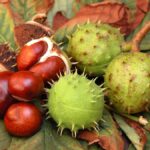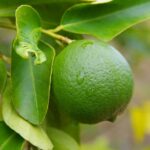You’ve tried fresh chopped chives added to sour cream and served as a filling for a baked potato.
But how about chives added to sour cream to serve with borscht and tomato soup?
Fresh-picked and snipped chives are a tasty garnish or flavoring in omelets, scrambled eggs, salads, and soups. Chives are also a perfect flavor partner for asparagus, butter, chicken, cream, cucumbers, fish, leeks, and seafood.
Chives are at their flavorful best when tender and green in spring. But you can keep a clump of chives in a pot on the kitchen window sill and have fresh chives to cut most of the year.
The classic herb combination—often called fines herbes—is equal parts of chopped fresh chervil, parsley, tarragon, and chives. Fines herbes are most flavorful when added to an already cooked dish before serving. That goes for chives, too.
Chives have a light onion aroma and a spicy, onion flavor. Their crunchy texture and fresh, garden-green appearance will liven up cream cheese, smoked salmon, broiled meats, root vegetables, and zucchini.
Ways to serve chives
Use chives raw or dried in salads, vegetables, poultry, fish, soups, sauces, eggs, cheeses, butter, or vinegar. Chives can be added to dishes both warm and cold.
- Add chives at the very end of cooking to preserve their flavor or, better yet, do not cook them at all and add them just before serving.
- Chives add a mild onion flavor. Use them to flavor and garnish vinaigrettes, mayonnaise, salads, dips, sauces, cheeses omelets, pasta, tofu, seafood, and meat.
- Use Chinese chives to add a mild garlic flavor to stir-fries, soups, and pickles.
- Chive blossoms can be eaten just when coming into bloom.
- Dried chives can be reconstituted by moistening with a salad dressing or lemon juice.
How to choose chives
Select chives that are fresh with evenly green leaves. Avoid chives that are soft or dry.
Chives harvest time
If you grow your own chives, clip the stems by one-third when they reach 3 to 4 inches (7.5-10 cm) tall, then allow the stems to grow on. Clip again by one-third when 5 to 8 inches (13-20 cm) in height. Stop harvesting chives three weeks before the first frost date and allow the colony to expand.
How to store chives
Chives will keep in the refrigerator for 3 to 4 days in a sealed plastic bag. Put them on a top shelf or in the warmest part of the refrigerator.
You can dry chives in a microwave or oven for winter use.
Chives nutrition
Chives have limited nutritional value because they are used in small amounts.
About chives
Chives are hardy, cool-season perennials and the smallest member of the onion family. They grow in clusters of slender, round, and hollow grass-like leaves similar to clumps of onions. The grass-like leaves typically reach 12 to 18 inches (30-45 cm) tall, but they will be most tender when harvested at about 6 inches (15 cm) tall. The leaves grow from tiny, barely formed white bulbs just below the soil surface.
Pink, white, or purplish flowers will blossom at the tip of unharvested stems. Chives bloom in late spring and early summer. All parts of the chives plant are edible. American Shakers used the purple-blue blossoms of common chives in their blue-flower omelet.
Chives grow wild in North America, Europe, and Australia. The plant thrives in chilly to warm and hot temperate regions. As the weather warms, chives become more oniony in flavor.
Cultivated chives are the descendent of a wild plant that originated in the mountainous regions of Central Europe. They were not cultivated in European gardens until the sixteenth century.
The name chive comes from the Latin word for onion cepa.
The botanical name of common or European chives is Allium schoenoprasum.
Garlic chives
A variety of chives called garlic chives or gau choi in Cantonese has been grown in China for more than a thousand years.
Garlic or Chinese chives are an important ingredient in Asian cooking. The flavor of Chinese chives is more pronounced than Western chives with a sweet to sharp, garlic taste.
Yellow chives are Chinese chives that have been grown with little light. Yellow chives are tender and mild tasting.
Chinese chives and yellow chives are tasty when served with bean sprouts, beef, bok choy, fish, pork, salads, water chestnuts, and yard-long beans.
Chinese chives grow in clumps with each bulb sprouting four or five narrow flat leaves that reach 14 to 18 inches (36-45 cm) long.
The botanical name of Chinese chives is Allium tuberosum.
Articles of interest:
Best Herbs for Container Growing
Garden Planning Books at Amazon:
- Vegetable Garden Almanac & Planner
- Kitchen Garden Grower’s Guide Vegetable Encyclopedia
- Vegetable Garden Grower’s Guide
- Tomato Grower’s Answer Book
More kitchen tips:
Bring your harvest to the table. Kitchen prep tips and easy recipes for the vegetables you grow. Click below for vegetable prep and recipes you can use now.
- Almonds
- Apples
- Apricot
- Aprium
- Artichoke
- Arugula
- Asparagus
- Avocado
- Bamboo Shoots
- Banana
- Basil
- Beans, Dried
- Beans. Long
- Beans, Shell
- Beans, Snap
- Beets
- Bitter Melon
- Blackberry
- Bok Choy
- Broccoli
- Broccoli Raab
- Brussels Sprouts
- Cabbage
- Cardoon
- Carrots
- Cauliflower
- Celeriac
- Celery
- Chard
- Chayote Squash
- Cherimoya
- Cherries
- Chestnut
- Chickpea
- Chinese Cabbage
- Chives
- Cilantro
- Citron
- Clementine
- Collards
- Coriander
- Corn, Sweet
- Corn, Baby
- Corn Salad, Mache
- Cranberry
- Cress
- Cucumber
- Daikon
- Dandelion
- Dill
- Eggplant
- Endive, Belgian
- Endive and Escarole
- Fava Beans
- Fig
- Florence Fennel
- Garlic
- Ginger
- Grapefruit
- Grapes
- Guava
- Horseradish
- Jerusalem Artichoke
- Jicama
- Jujube
- Kale
- Kiwifruit
- Kohlrabi
- Kumquat
- Leeks
- Lemongrass
- Lemons
- Lettuce
- Lime
- Mache (Corn Salad)
- Mandarin Orange
- Mango
- Maple Syrup
- Marjoram
- Melons
- Michihili
- Mint
- Mizuna
- Mushrooms
- Mushrooms, Cremini
- Mustard Greens
- Napa Cabbage
- Nectarine
- Okra
- Olives
- Olive oil
- Onions
- Oranges
- Oregano
- Parsley
- Parsley Root
- Parsnips
- Passion Fruit
- Pawpaw
- Peaches
- Pears
- Peas, Garden Snap
- Peas, Snow
- Pei Tsai
- Peppers, Chili
- Peppers, Sweet
- Persimmon
- Pineapple
- Pineapple Guava
- Plantain
- Plums
- Pluots
- Pomegranate
- Potatoes
- Prickly Pear
- Pumpkin
- Quince
- Radicchio
- Radishes
- Raspberries
- Rosemary
- Rhubarb
- Rutabaga
- Sage
- Salsify
- Sauerkraut
- Savory
- Shallots
- Sorrel
- Spinach
- Squash, Summer
- Squash, Winter
- Strawberries
- Sunchokes
- Sunflower
- Sweet Potato
- Swiss Chard
- Tangerine
- Taro
- Tarragon
- Thyme
- Tomatillo
- Tomato
- Turnip
- Turnip Greens
- Yams















